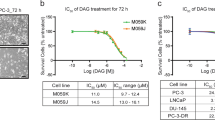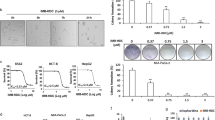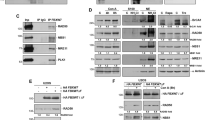Abstract
To study molecular aspects of cytotoxicity of the anticancer drug β-D-glucose-ifosfamide mustard we investigated the potential of the agent to induce apoptosis and DNA breakage. Since β-D-glucose-ifosfamide mustard generates DNA interstrand crosslinks, we used as an in vitro model system a pair of isogenic Chinese hamster V79 cells differing in their sensitivity to crosslinking agents. CL-V5B cells are dramatically more sensitive (30-fold based on D10 values) to the cytotoxic effects of β-D-glucose-ifosfamide mustard as compared to parental V79B cells. After 48 h of pulse-treatment with the agent, sensitive cells but not the resistant parental line undergo apoptosis and necrosis, with apoptosis being the predominant form of cell death (70 and 20% of apoptosis and necrosis, respectively). Apoptosis increased as a function of dose and was accompanied by induction of DNA double-strand breaks in the hypersensitive cells. Furthermore, a strong decline in the level of Bcl-2 protein and activation of caspases-3, -8 and -9 were observed. The resistant parental cells were refractory to all these parameters. Bcl-2 decline in the sensitive cells preceded apoptosis, and transfection-mediated overexpression of Bcl-2 protected at least in part from apoptosis. From the data we hypothesize that non-repaired crosslinks induced by β-D-glucose-ifosfamide mustard are transformed into double-strand breaks which trigger apoptosis via a Bcl-2 dependent pathway.
This is a preview of subscription content, access via your institution
Access options
Subscribe to this journal
Receive 24 print issues and online access
$259.00 per year
only $10.79 per issue
Buy this article
- Purchase on Springer Link
- Instant access to full article PDF
Prices may be subject to local taxes which are calculated during checkout









Similar content being viewed by others
References
Allen RT, Cluck MW, Agrawal DK (1998) Mechanisms controlling cellular suicide: role of Bcl-2 and caspases. Cell Mol Life Sci 54: 427–445
Bratton SB, MacFarlane M, Cain K, Cohen GM (2000) Protein complexes activate distinct caspase cascades in death receptor and stress-induced apoptosis. Exp Cell Res 256: 27–33
Cheng EH, Kirsch DG, Clem RJ, Ravi R, Kastan MB, Bedi A, Ueno K, Hardwick JM (1997) Conversion of Bcl-2 to a Bax-like death effector by caspases. Science 278: 1966–1968
Dimmeler S, Breitschopf K, Haendeler J, Zeiher AM (1999) Dephosphorylation targets Bcl-2 for ubiquitin-dependent degradation: a link between the apoptosome and the proteasome pathway. J Exp Med 189: 1815–1822
Dunkern T, Fritz G, Kaina B (2001a) Ultraviolet light-induced DNA damage triggers apoptosis in nucleotide excision repair deficient cells via Bcl-2 and CD95-independent caspase-8 activation. Oncogene 20: 6026–6038
Dunkern T, Fritz G, Kaina B (2001b) Cisplatin-induced apoptosis in 43-3B and 27-1 cells defective in nucleotide excision repair. Mutation Res 486: 249–258
Enari M, Sakahira H, Yokoyama H, Okawa K, Iwamatsu A, Nagata S (1998) A caspase-activated DNase that degrades DNA during apoptosis, and its inhibitor ICAD. Nature 391: 43–50
Lips J, Kaina B (2001) DNA double-strand breaks trigger apoptosis in p53 deficient fibroblasts. Carcinogenesis 22: 579–585
Ochs K, Kaina B (2000) Apoptosis induced by DNA damage O6-methylguanine is Bcl-2 and caspase-3 regulated and Fas/Caspase-8 independent. Cancer Res 60: 5815–5824
Olive PL, Wlodek D, Banath JP (1991) DNA double-strand breaks measured in individual cells subjected to gel electrophoresis. Cancer Res 51: 4671–4676
Seker H, Bertram B, Wießler M (1996) Possible role of the cytosolic β-glucosidase in the metabolism of saccharide-coupled platinum and ifosfamide mustard in tumour cells. In 10th Mediterranean Congress of Chemotherapy Berkarda B (ed) pp 381–385, Monduzzi Editore
Seker H, Bertram B, Burkle A, Kaina B, Pohl J, Koepsell H, Wiesser M (2000) Mechanistic aspects of the cytotoxic activity of glufosfamide, a new tumour therapeutic agent. Br J Cancer 82: 629–634
Singh NP, McCoy MT, Tice RR, Schneider EL (1988) A simple technique for quatitation of low levels of DNA damage in individual cells. Exp Cell Res 175: 184–191
Sun XM, MacFarlane M, Zhuang J, Wolf BB, Green DR, Cohen GM (1999) Distinct caspase cascades are initiated in receptor-mediated and chemical-induced apoptosis. J Biol Chem 274: 5053–5060
Telleman P, Overkamp WJI, van Wessel N, Studzian K, Wetselaar L, Natarajan AT, Zdzienicka M (1995) A new complementation group of Mitomycin C-hypersensitive Chinese Hamster cell mutants that closely resembles the phenotype of Fanconi anemia cells. Cancer Res 55: 3412–3416
Veyhl M, Wagner K, Volk C, Gorboulev V, Baumgarten K, Weber W M, Schaper M, Bertram B, Wiessler M, Koepsell H (1998) Transport of the new chemotherapeutic agent beta-D-glucosylisophosphoramide mustard (D-19575) into tumour cells is mediated by the Na+-D-glucose cotransporter SAAT1. Proc Natl Acad Sci USA 95: 2914–2919
Wesselborg S, Engels IH, Rossmann E, Los M, Schulze-Osthoff K (1999) Anticancer drugs induce caspase-8/FLICE activation and apoptosis in the absence of CD95 receptor/ligand interaction. Blood 93: 3053–3063
Acknowledgements
This work was supported by Deutsche Forschungsgemeinschaft, DFG Ka756/4-4, Rheinland-Pfalt SFB 519/B4, and Stiftung.
Author information
Authors and Affiliations
Corresponding author
Rights and permissions
About this article
Cite this article
Becker, R., Ritter, A., Eichhorn, U. et al. Induction of DNA breaks and apoptosis in crosslink-hypersensitive V79 cells by the cytostatic drug β-D-glucosyl-ifosfamide mustard. Br J Cancer 86, 130–135 (2002). https://doi.org/10.1038/sj.bjc.6600027
Received:
Revised:
Accepted:
Published:
Issue Date:
DOI: https://doi.org/10.1038/sj.bjc.6600027
Keywords
This article is cited by
-
An in vitro cytotoxicity of glufosfamide in HepG2 cells relative to its nonconjugated counterpart
Journal of the Egyptian National Cancer Institute (2021)
-
Combination of cyclophosphamide and double-stranded DNA demonstrates synergistic toxicity against established xenografts
Cancer Cell International (2015)
-
Aerenchyma formation in maize roots
Biologia plantarum (2009)
-
Apoptosis triggered by DNA damage O6-methylguanine in human lymphocytes requires DNA replication and is mediated by p53 and Fas/CD95/Apo-1
Oncogene (2004)



